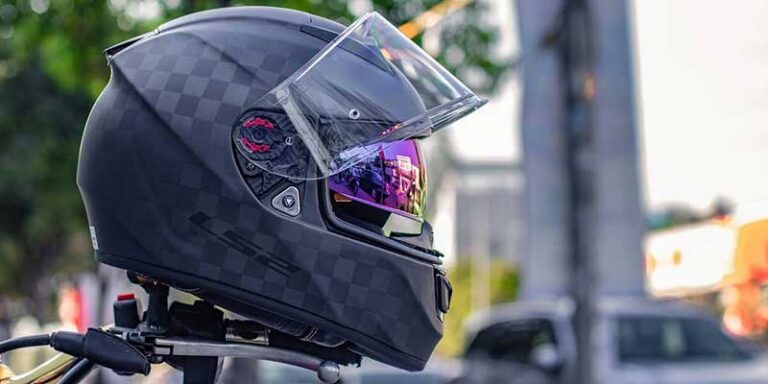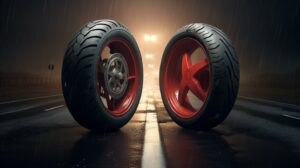Considering buying a new helmet? Do not focus simply on the colors and graphics. It is important to choose a helmet that is the correct size and shape for your head. While there are many different styles of helmets, each brand will fit slightly differently. These differences affect how tight or lose the fit feels on your head.
The level of safety that your helmet offers greatly depends on its fit. A properly fitted helmet reduces the risk of a brain injury and minimizes head and neck injuries in case of an accident.
Helmet manufacturers spend countless hours fitting heads for specific sizes and shapes with various internal padding configurations. The best way to find out how tight or loose a helmet will feel is to actually try one on instead of just guessing your size based upon your current motorcycle helmet size.
In the size guide, we will cover the most important aspects that you need to keep in mind while selecting a well-fitted helmet.
How Tight Should Your Motorcycle Helmet Be?
A helmet should fit snugly on your head, but it shouldn’t be too tight. It’s helpful to have another person help you put the helmet on for this process.
Effective motorcycle helmets reduce injury risk by protecting your skull and brain from impact. A good rule of thumb is if the helmet feels uncomfortable, it probably isn’t a safe fit. When you are trying on a new motorcycle helmet make sure that the helmet fits snug against your brow while allowing you to open your mouth wide without feeling pressure points or pinching anywhere on the inside of the face shield or around your chin area.
If there are pressure points, try adjusting how far back on your head you position each side of the chin bar. Make adjustments until it’s easy to open your mouth wide and you feel no pressure points.
An uncomfortable, ill-fitting motorcycle helmet might still look cool, but it’s probably not a good choice for riding. When you ride, your helmet should sit squarely on the top of your head. It shouldn’t tilt backward to expose parts of your forehead or press forward to cover your eyes, nose, and mouth. When you open your mouth, the bottom of the face shield or goggles should lift away from your skin to prevent pinching or scratching, especially if you wear glasses under your helmet.
How To Find The Best Fit?
Some vital concepts that need to be considered while selecting the helmet that fits you best are:
- Helmet Fit
- Shape
- Types of Motorcycle Helmet
- Sizing a Motorcycle Helmet
Helmet Fit
It might sound strange, but when you wear a new helmet it must be slightly tight. If a helmet feels too loose, it may shift around on your head at higher speeds. It can even come off during a crash if not strapped tightly under your chin. Buy the correct size so that the fit is snug without being uncomfortable or painful.
With time, the helmet adjusts to the structure of your face and is less likely to come off during a crash. If you can’t find a comfortable fit with the smallest size, move one size up and try it again.
A snug fit ensures your helmet won’t shift or rock back and forth on your head, even at higher speeds. A properly fitted motorcycle helmet should feel just tight enough so that if you open your mouth really wide, the helmet might press down on your face slightly.
Shape
The best way to check if a given model of a motorcycle helmet fits you is by trying it on—preferably with a sort of “buddy fitting.” You have to know for sure that the shape of any given new brand or model of helmets will suit you precisely because manufacturers produce many different helmet shapes and sizes for different head types.
There are generally three primary shapes of a helmet – oval, intermediate, and round. If you have an oval head shape, your forehead is longer than the back section of your skull. The other two helmet shapes are usually for those with a round-shaped head and those whose head length and width match each other fairly well.
Types of Motorcycle Helmet
- Open-face helmets
Open-face helmets, also known as a three-quarter or convertible-style helmets, typically have a chin bar that flips up to allow you to easily lift the face shield out of your way when it’s time to take a break from the wind. Most open-face helmets are very comfortable but offer less protection than full-face motorcycle helmets because they don’t cover everything above the bridge of your nose.
- Full-Face Helmets
Full-face helmets provide maximum coverage with added security features like a locking face shield mechanism and reinforced chin bars to protect against impact during a crash. Many models include detachable face shields that can be replaced if scratched or lost.
- Half-Shell Helmets
Half-shell helmets, also known as “shorty” or “beanie” motorcycle helmets, are lighter and more compact than full-face models because they don’t have a chin bar. Some half-shell helmet models wrap around the edges to meet at the back of the head for added comfort and safety. These helmets typically provide less coverage than other types.
- ADV Dual Sport Helmets
ADV dual-sport helmets combine the coverage of a full-face helmet and the wide vision and ventilation of an open face. Similar to both kinds of half-shell helmets, these offer more convenience than other types because you can easily flip up the visor to talk to someone or take a drink without removing your entire helmet.
- Modular Helmets
Modular helmets include a chin bar that can be flipped up and locked with one hand. You can easily lift the visor to take a drink or talk with others, and then flip it back down before you hit the highway. Most modular helmets offer greater all-around protection than half-shell alternatives because of this feature and their sturdy chin bars.
Sizing a Motorcycle Helmet
Now that you’ve chosen the helmet shape and type, it’s time to get your head size. The only way to do this is by visiting your local motorcycle dealer with your hat or hairstyle (if wearing a hat) in mind. The best way to know is by using a tailor’s tape measure to find the circumference of your head.
Wrap the measuring tape around your head just above your eyebrows and ears, keeping the tape straight across the back of your head. This is your approximate head circumference. If you come up with a measurement between sizes, choose the smaller size to get a snugger fit or the larger size if you want extra room inside for comfort.
Conclusion
A helmet that doesn’t fit correctly is uncomfortable and can affect your ability to focus on the road. Whenever possible, it’s best to try on masks before you buy them. A good shop will let you do this, or even provide a trial period for you to see if it’s working out for you.
Never buy a helmet without trying it on first—it’s the only way to know for sure if it feels right. If you’re shopping online or in-person, ask if there are any helmets that may be open-box items at a cheaper price without the tag attached. Some stores will allow this to happen during certain days of the year like Black Friday (check your local ads) and the last day of the month.
For some of the quietest helmets on the market, see how recommended quietest motorcycle helmet’s article.






